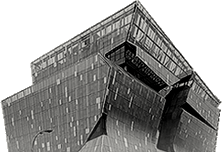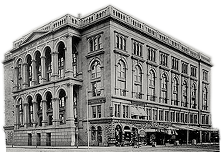Summer Art Intensive Blog
Poetry Writing and Contemporary Art Issues
POSTED ON: November 21, 2017

The Whitney Museum of American Art Summer 2017 “To Organize Delirium” by Hélio Oiticica
by Erica Miriam Fabri
There is no better way to spend July for a young artist than by being immersed in art-making and the literal and physical act of immersing oneself into the art of professionals. Each summer, in addition to three days a week of intense art classes, the teen artists of the Cooper Union Summer Art Institute (CUSAI) spend the fourth day with a morning Poetry Writing and Contemporary Art Issues course, then the afternoon on group field trips to a variety of New York City exhibits.
As a poet and art-lover, it has been a true joy to teach writing to the high school students of the CUSAI and to take these mini-journeys to various New York City art-destinations. This past summer, the exhibits we traveled to were particularly interactive. At the Socrates Sculpture Park we climbed on top of Nari Ward’s 40-foot “Scapegoat” sculpture. Students stepped along the neck of the goat with careful balance as if it were a tight rope. They sprawled their bodies over the giant animal-head and ran their hands along the ridged texture of its face. At the Whitney, we spent hours at the Hélio Oiticica exhibit; we took off our shoes and dipped our toes into pools of fountain water and buried our feet in an indoor sand beach. In a mock dressing room, we tried-on the wildly colored fabrics that made up Oiticica’s “Parangolé,” and in another room, with walls covered in projections, we rocked in hammocks.
The exhibits were endlessly inspiring and the inspiration was doubled by experiencing it alongside the CUSAI teens. As visual artists-in-training they were able to grip the edges of, and actually climb inside, the work we were studying. All members of the group were visual artists; some were also eager poets; others were more reluctant to call themselves writers. Their weekly assignment was to take notes during our field trips and then use those notes for a poetry assignment. The following week, even the self-proclaimed anti-poets brought rare and fascinating writing to the classroom.
After four weeks together, all participants, instructors, friends and family gathered together for a final exhibition; this time we did not trek to an outside gallery, but instead, we witnessed the walls of The Cooper Union adorned with the work that the teen artists had created over the past month. All visitors were engaged by these masterpieces with equal admiration as was given to the artists at The Whitney, The New Museum and The Met. Included in the presentation was an animation viewing and a poetry reading. As an adult artist and instructor, seasoned and blessed with a career in the arts, I left on that last day feeling bittersweet: sad to see the month end, but with a heart full of enthusiasm to create more. The CUSAI leaves a profound impact on both students and instructors alike. Its value crosses the boundaries of age, genre and style. It is an ideal experience for new art-makers, who need to test the waters of artistic creation and conversation.
Between Leading and Listening
POSTED ON: September 28, 2017

By Sarah Philips
When I first signed up for a Teaching Assistant position at the summer, I never could have expected the wild ride that my July was about to become. Over the course of the Cooper Union Summer Art Intensive, I grew to empathize with and understand my own teachers to a degree that I never had before. I realized the amount of emotion, time, and energy they expend in order to help their students. As a TA, I was in a strange position, both teacher and student while being truly neither. Working one-on-one with Rob, my drawing instructor, required a vastly different mindset than when I was working directly with my students. I found that not only did the students often come to me for serious questions about Cooper and impending college applications, but we were able to share a certain humor, unadulterated by the compounded stresses of life and work after high school. Being closer in age and experience, they were less intimidated by me and more open to being playful.
In my short stint as a TA, in my view to teach is to straddle a line between leading and listening, serious and experimental. The students have to feel like they have the power to ask questions and receive real answers. As a teacher, taking a student seriously is the first step for a student to take themselves seriously. This is what Rob and I strove to do in our drawing class. We gave our students the space to think for themselves. If we saw them struggling with a concept or technique, we would step in and lend them a hand, but otherwise they produced their art on their own. Our free form and somewhat vague prompts were devised to push students to interact with their materials and subjects in ways they probably hadn’t been encouraged to before. I believe this approach yields much more self-conscious and driven work.
Classes that focus on the purely representational aspects of drawing are useful, but miss the point of drawing as an exercise in thought. Drawing is a fantastic way to develop ideas visually and to communicate these ideas to other people or to your future self. The process of drawing is as important as the finished (or unfinished!) piece. To be aware of your inclinations, influences, observations, and anything else that might unconsciously push your work one way or another, and be able to take them apart and analyze them is a hard skill to learn and an even harder one to teach. It requires a degree of comfort, or at least familiarity, with uncertainty and anxiety. It’s arguably harder to work without constraints rather than within them; the key is to understand how you work and to develop your own constraints based on what you want to see.
High school is a time notable for its bureaucratic nonsense, college applications, parent signed forms, authoritative teachers, and stringent social groups that each jostle for the attention and energy of the student in question. These things strip power from the student and cause them to doubt themselves and distrust authority, while in turn conditioning them to expect these kinds of dynamics later in life. While I can’t yet do anything to fight this self-feeding cycle on a large scale, my goal in this program was to at least give my students a space where they could talk to me person to person, both serious and playful, and work things out for themselves. In this way, I hope I encouraged at least some of them to begin to break away from their precious conceptions about drawing, life and high school. Theirs is a tough trail to blaze, all we can do is try to give them the tools to do so.
Contemporary Art Issues from Both Sides of the Classroom
POSTED ON: April 20, 2017
By Masha Vlasova
In high school I loved to draw. I was excited to attend the Cooper Union’s Summer Art Program primarily because of the numerous hours of drawing instruction a week. I knew nothing about contemporary art and thought I didn’t like it. At the Metropolitan Museum of Art, I was drawn to Claude Monet’s Rouen Cathedral series. I didn’t quite know why I liked them, perhaps because they were “realistic.” Needless to say, when I found out that in addition to drawing at CUSAI, we were expected to attend something called “Contemporary Art Issues,” and that it involved writing and discussion about said “issues,” I was intimidated.
From day one we were expected to share our observations, feelings, and interests in writing and discussion in response to museum trips and studio visits with contemporary practitioners. Our instructors and TAs dragged us all over the five boroughs. One memory that stuck with me was attending a Bowery Poetry Club reading. Later in class we responded to this experience with our own poetry. It was unusual (and for that reason exciting) to be put in dialogue with an established living poet’s work. Just as it was new and exhilarating to visit an artist’s studio and ask them questions about their craft and see their process “behind the scenes.” No one never told us that art we were looking at was “good” or “bad.” Instead the instructors insisted we define this for ourselves. At the time, I probably wasn’t able to articulate how and why this course was important for my development. I just knew that I was being exposed to something entirely different and new.
Thankfully not all lessons need to be translated into language in order to be internalized.
At the Cooper Union and later at Yale School of Art to my own surprise I didn’t focus on painting or drawing but rather turned to video, performance, and text. I still visit Claude Monet’s Rouen Cathedral series every time I go to the Met. I’ve come to appreciate these works as mediations of time, concerned with light and the particular political moment of their creations. When I was a student, Contemporary Arts Issues planted a seed that was later nurtured by my many teachers, mentors, and colleagues in college and graduate school. I seek to plant that very seed when I teach this course.
No Contemporary Arts Issues class is like another. Designing the course is a research project in its own right. I look into programming at well-known museums, as well as small artist-run and alternative exhibition spaces. As I make lists of shows and artists, read biographies and press releases, different themes begin to emerge. Last summer we broadly focused on memory: cultural, historical, global, and personal. In class, prior to seeing Cornelia Parker’s Transitional Object (PsychoBarn) at the Met Roof Garden we discussed this theme broadly. What constitutes cultural memory? What constitutes appropriation? A Remake? A Copy? Later at the museums, I asked students to consider a different set of questions. How does the sculpture make our bodies feel? How does it relate to our bodies in space? To the space itself? What does it ask of us physically? Looking at art in a museum, gallery, or a specific site is essential to a well-rounded art education. Context grounds broad themes and metaphors in an immediate experience.
I love to work with students that are at the beginning of their arts career, when there is much potential for discovery. Often I see students coming in with an intended art major or a notion of what art is. It’s always exciting to see students expand their perspectives, as they begin to see what can be possible. Seeing students transform from being intimidated by new perspectives and possibilities to feeling empowered and excited by them is what makes teaching this course so rewarding.
2017 Artists in Residence Announced
POSTED ON: March 30, 2017

Tammy Kiku Logan, Julia Norton, Kate Starbuck Elliot and Florine Demosthene (l to r)
The Summer Art Intensive is thrilled to announce its 2017 Artists in Residence. Tammy Kiku Logan is an artist and educator working in Brooklyn, N.Y. Kate Starbuck Elliot is a native New Yorker currently living and working in Brooklyn. Simulated oases, adventure game shows, and gymnastics are amongst the varied references in Julia Norton’s (b.1985, New York City) ongoing exploration of environment, body, and form. Florine Demosthene is an artist, designer, educator and global citizen.
For more about these artists, see our Artists in Residence page.
Tags: Stephanie Hightower




